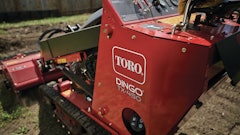Sectional barges are becoming a more common component of aquatic earthmoving operations. Their advantage is that they can be easily moved across land from jobsite to jobsite.
"Poseidon sectional barges are portable," says Mike Lane, product manager, Poseidon Barge Corp. "They can be trucked to the project location and off loaded and set up with an 80-ton crane or larger."
This is important for inland waters and rivers that are not accessible using larger deck river barges. "Our 40' x 10' x 5' barges are light enough that we can legally haul two [of them] on a lightweight step-deck trailer, reducing the freight and the number of trucks going to and from the jobsite," Lane notes. However, because they measure 10 ft. 4 in. wide, they do require over-width permits for transport.
The barges enable excavators and other equipment to work in shallow waterways. "Each 40' x 10' x 5' barge will draft 12 in. empty and 2' 6" with 35,000 lbs. dead weight on the barge," says Lane. "We recommend a minimum size deck of 30' x 40' to float a Caterpillar 322 size excavator along with two spuds and spud pockets to hold the barge in place while working. This provides the necessary platform size and also allows the operator the ability to reach over the edge of the barge without concern for the barge flipping over."
Of course, you need to make sure the barge holds its position. "Spuds are used to secure the barge in place," says Lane. "The spuds appear to look like large nails. They are fabricated from 18" x 1/2" wall pipe. Each has a 20-in. sheave at the bottom. A double-drum winch allows you to cable both spuds with one winch to raise and lower the spuds. Additional 2-in. holes are fabricated into the sides of the spuds every 60 in. This allows the contractor to pin the spud up, taking the weight off the winch cable while moving the barge."
Setting up a sectional barge is not overly complex. "Typical setup for an excavator barge can be completed in eight hours," says Lane. "A portable weld unit is required if there is a hydraulic barge pusher or a double-drum winch to raise and lower the spuds. Both the winch and pusher must be tack welded to the barge once their location is determined. The winch will also require the location and tack welding of vertical lead blocks to direct the 5/8-in steel cable over the edge of the barge down to the sheave at the bottom of the spud."
Once the job is done, the crane is brought back in for teardown. "The contractor will require an 80-ton crane or larger to pick the barges out of the water to load them on the trucks," says Lane.
















